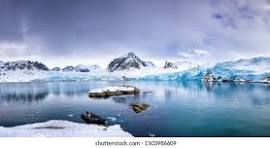|
|
|

 | Simo Jelača | |
| |
detail from: KRK Art dizajn
NORTH AND SOUTH POLE(Similarities and differences)
Dr Sci. SIMO JELAČA
The Earth's North Pole (Arctic) is located on the Arctic Ocean, surrounded by land, at an altitude of only 2 m, at a distance of about 700 km from the mainland of Greenland. The South Pole (Antarctica) is located on land, surrounded by sea. Antarctica is a continent, and the south pole is located at an altitude of 2,835 m, about 1,300 km from South America.At the North Pole, daily temperatures range from 5 to -43 degrees Celsius, and at the South Pole from -13.5 to -62 degrees Celsius, so the temperatures are lower at the South Pole. One reason is that cold winds circulate around Antarctica. The lowest temperature in Antarctica was recorded on July 21, 1983 at -89.2 degrees Celsius, and the highest temperature recorded at the North Pole was 5 degrees, when it was -13.5 degrees at the South Pole on the same day. At the place marking the South Pole, a pole was placed, which they say moves by 10 m every year. The ice at the North Pole is about 3 to 4 m thick, and the ocean below it is 426 m deep, while at the South Pole the thickness of the ice is as much as 2700 m, which means that the mountain on which the South Pole is located is almost entirely made of ice. Both poles are under permanent ice. The ice in the vicinity of the South Pole melts during the summer on the seashores, and freezes again in the winter, so the area of Antarctica doubles in winter compared to the summer area. In both hemispheres, winters are long and very cold, and summers are short and cold. Both pols have five months of daylight each year, then one month of twilight, then five months of night and one month of twilight again. Both pols have one sunrise and one sunset each year. At the North Pole, the sun rises on the day of the March Equinox and does not set until the autumnal September Equinox.On June 21, the Arctic has the middle of summer, and the day lasts exactly 24 hours, while on that day it is the middle of winter in the Antarctic, where the night lasts 24 hours. It's the other way around on December 21, it's the middle of winter in the Arctic and the middle of summer in the Antarctic. The name Antarctica has the opposite meaning of the name Arctic (according to the meaning in the Greek language).Antarctica was discovered in 1912 and is the fifth continent on planet Earth, measuring 13,176,727 square kilometers. At the South Pole, the magnetic needle is placed on a horizontal axis and occupies a vertical position. Antarctica is surrounded by three oceans; The Pacific, Atlantic and Indian Oceans and the five seas; Weddell's, Ross's, Bellinghausen, Amundsen's and Scotti's seas. Antarctica is accessible to scientists from all nations of the world. There is also a lake in Antarctica, the size of 4.7 square kilometers, in which the water temperature is 11 degrees Celsius. There is also a geyser in which the temperature is 88 degrees Celsius.
The plant life at the North Pole of the Earth consists of tundra, low-growing shrubs, grasses, mosses and some alpine flowers, all of which grow on the flat and hilly terrains that surround the Arctic Ocean, an area of 11.5 million square kilometers. Data indicate that as many as 1,700 different types of plant life grow in the Arctic. In Antarctica, the flora is much poorer. Algae and lichens mainly grow there between the stones. Reindeer, mouflon, arctic hares, arctic foxes, snowy owls, squirrels, and polar bears live in the Arctic animal kingdom. And only some small flies live in Antarctica, which are wingless, 12 mm in size. Among the larger animals that live in Antarctica are penguins and seals, and among the birds are albatross and mammals in the oceans are whales and seals.Among the human races that live closest to the Arctic are the Inuit, the Chukchi, the Lapps, the Jupita, and the Inupiki. There are no human communities in Antarctica. Only researchers stay there, but not as permanent residents. Hence, the biggest difference between the north and south poles is the human presence. No one has ever been born in Antarctica, nor has anyone lived there for the rest of their lives. About 4,000 to 5,000 researchers visit Antarctica annually, of which about 1,000 stays in the winter.It is officially stated that the Norwegian Ruan Engelbert Craving Amundsen led the first explorer expedition from 1910 to 1912, when he discovered the South Pole of the Earth. The Russians, however, claim that they discovered the South Pole on January 28, 1820, with the ship "Mirniy''. The captain of the ship was M. Lazarov. The Antarctic is rich in ores, the exploitation of which is being researched, while the Arctic is rich in underwater oil.
 
View from the North Pole Marking the South Pole
|

















